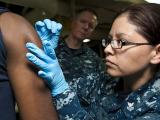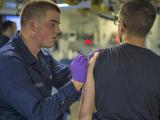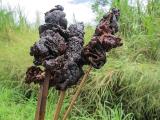Aug 21, 2003 (CIDRAP News) – Initial tests of the new cell-culture–grown smallpox vaccine now being stockpiled by the US government indicate that it may be slightly safer than the vaccine used in the current immunization program, according to a report by the vaccine's manufacturer.
Acambis Inc., developer of the new vaccine, called ACAM1000, said this week that animal studies suggest that the vaccine may be less likely to trigger encephalitis than Dryvax, the older vaccine from which it was derived. Both vaccines use vaccinia virus, a relative of the smallpox virus.
In a report in Nature Medicine, published online Aug 17, Acambis scientists state that ACAM1000 "probably represents an advance over Dryvax in terms of purity, quality, freedom from bacterial contamination allowed in the old vaccine, the absence of bovine adventitious agents and a possible lower incidence of postvaccinial encephalitis." Historically, encephalitis occurred at a rate of about 3 to 12 cases per million first-time smallpox vaccinees (see CIDRAP overview on smallpox).
Dryvax, the vaccine used routinely in the United States before smallpox was eradicated and now being used to immunize military personnel and some health workers , was grown in the skin of calves. ACAM1000 is described as a purified clone of Dryvax that is grown in human cells in a laboratory. Acambis, in partnership with Baxter Healthcare Corp., is under contract to produce 209 million doses of smallpox vaccine for the US government.
In a news release, Acambis officials said their initial research for the project showed that Dryvax "contained multiple subpopulations of virus, including variants that were highly virulent in pre-clinical models." The company concluded that it was not acceptable to make the new vaccine "simply by inoculation of the first-generation product into cell culture."
Consequently, the company prepared several clones of Dryvax in the hope of finding one with similar effectiveness and an equal or improved safety profile. The clones were tested for safety and immunogenicity in mice, rabbits, and monkeys, according to the journal article. A clone that showed good immunogenicity and had a reduced likelihood of triggering encephalitis when injected into mouse brains was designated as ACAM1000. In a further safety test, researchers injected ACAM1000 and Dryvax into groups of six rhesus monkeys. Three of the monkeys injected with Dryvax died of neurologic illness, while the six monkeys injected with ACAM1000 survived with minimal effects. Other animal tests showed that ACAM1000 was equivalent to Dryvax in generating an immune response.
For the clinical trial, two groups of 30 young adults were inoculated with ACAM1000 or Dryvax and followed for 6 months. All 30 of the ACAM1000 recipients had a vaccination "take" within 10 days, compared with 29 of the 30 Dryvax recipients. Results were similar for the development of vaccinia-specific antibodies by 45 days after vaccination. No serious adverse events occurred in either group, and the rates of mild and moderate side effects in the two groups did not differ statistically.
The report notes that clinical trials are not large enough to predict the rate of serious side effects that might occur if a vaccine were used widely. Dr. Thomas Monath, chief scientific officer for Acambis, commented in the news release, "While we cannot prove, without large-scale human experience, that our vaccine is safer for humans with respect to a lower incidence of postvaccinial encephalitis, this remains a possibility based on the preclinical data."
Weltzin R, Liu J, Pugachev KV, et al. Clonal vaccinia virus grown in cell culture as a new smallpox vaccine. Nature Med 2003 (early online publication, Aug 17) [Abstract]

















